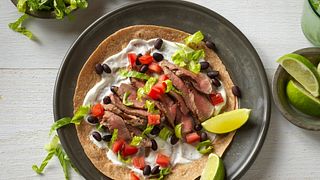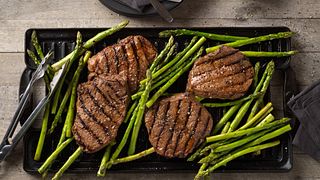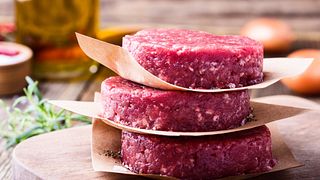Impact of Current Inflationary Trends on the Beef Industry
September 28, 2022
Inflation, or the increase in prices consumers pay for goods and services, has been one of the most talked about topics of 2022. Most common consumer goods have experienced abnormal price increases to some degree. While the causes of inflation rates not seen since the 1980s have been debated far and wide, the results are indisputable: consumers have experienced a greater strain on their incomes and household budgets than they likely have in some time. While some goods can be substituted for cheaper alternatives or omitted from shopping carts entirely, other goods – such as food, fuel, and clothing – cannot be simply lived without. Inflationary pressures on these types of goods, known as inelastic goods, are especially concerning considering their importance to individual wellbeing. However, price is but one of the five demand drivers that affect consumers’ purchasing decisions. This article aims to explore recent beef inflationary trends and their impact on beef demand.
Current Inflationary Trends
To accurately assess beef’s performance from a price standpoint, it may first be helpful to identify which sectors have also been experiencing inflationary pressures. For example, Figure 1 showcases the eight major groups measured by the Bureau of Labor Statistics for the Consumer Price Index (CPI). This index measures the cost for a certain basket of goods and tracks it in real-time, which allows for historical comparisons in the form of percentage changes. In order to ensure accurate reporting, the CPI produces two measurements: the seasonally adjusted index and the non-seasonally adjusted index. The non-seasonally adjusted index is most beneficial for comparing year over year changes in prices, while the seasonally adjusted index, which accounts for typical seasonal fluctuations, is most used for month over month price changes.
Figure 1 shows the price percent change from August 2021 – August 2022 for these eight major groups of goods. For reference, the Federal Reserve’s historical inflation target has been 2 percent for all items1. With that in mind, it is apparent why these percentage increases have been causing so much distress amongst consumers. Currently, the only category below the Fed’s target is Education and Communication, while the category currently the most out of touch with this target is Energy.
While food is not the only category that has experienced elevated prices from August 2021 – August 2022, it is one of the higher categories listed. Food price increases are especially concerning, as this may force lower-income consumers to sacrifice a healthy diet to make ends meet. As discussed earlier, the major inelastic goods – food, energy, and transportation – have all experienced the greatest increase, potentially since consumers are forced to purchase them regardless of the current price level. However, while these classifications are helpful to view the different sectors of the economy, each group contains many different subcategories that each could be experiencing various levels of increasing prices.
Throughout the different food categories (Figure 2), meats reported the lowest price increase, although all the percentage increases listed are far from ideal. According to Figure 2, the two categories driving the food at home price increases are the cereals and dairy categories. In fact, only the fruit and vegetable category experienced a lower increase in price than the meats category between August 2021 – August 2022. Again, this fact is relative, as all these increases are unusually high and causing strain on the economy.
This past month saw the highest percent increase for the food at home, cereals and bakery products, dairy and related products, and other food at home categories since 1985 (the base year for these categories is 1982 – 1984)2. Meats experienced its highest increase in May 2022, while fruits and vegetables experienced its highest increase in February 19902.
While these current price levels are unprecedented, volatile price shifts are not a new phenomenon for protein markets, as evidenced by Figure 3. The protein category tends to follow the direction of all items, but they may do so to a greater degree. These historic price swings within the protein sector have been caused by a variety of factors, from supply chain issues and shortages to shifts in demand due to the COVID-19 pandemic. While the protein sector is currently experiencing volatility, Figure 3 induces some optimism by showing that historic price swings do tend to come back into equilibrium.
Zooming further into the meats category within the broader food at home category, we can compare various popular protein groups in terms of relative price fluctuations. As evidenced by Figure 4, each protein category has experienced upward inflationary pressure over the past year. However, poultry and eggs are the only two categories to rise above the average for the meats category (which is also higher than normal).
Among the five categories that comprise the bulk of the meats category, beef experienced the lowest percent increase from August 2021 – August 2022, currently sitting at 2.5 percent. This constitutes a 37.8 percentage point differential from the egg category, which rose by 39.8 percent from August 2021 – August 2022. Poultry rose by 13.4 percentage points more than beef, pork by 6.2 percentage points, and seafood increased by 6.2 percentage points more than beef. While beef prices are still shifting upwards, Figure 4 shows that in comparison, beef prices have been holding relatively well as of August 2022.
Figure 5 shows the historical 1-month percent change for the beef CPI category from August 2012 – August 2022. Normal fluctuations can be seen to some degree, but a major shock (potentially due to the Covid-19 pandemic) affected beef prices around May 20202. However, shortly after the initial spike, prices declined, and have since avoided crossing above the 5 percent threshold. Figure 5 also highlights the fact that the current beef price month/month fluctuations are not completely abnormal. Looking to the 2013 – 2014 timeframes, prices fluctuated more than have been observed during 2022, at least for monthly, seasonally adjusted percent changes.
Within the beef category, price fluctuations have varied from August 2021 – August 2022 depending on the specific beef cut reported. For example, uncooked ground beef has accounted for much of the percent increase within the beef category, surpassing the next highest category by 2.9 percentage points. For reference, uncooked ground beef has risen by an average of 3.4 percent per year since 19852. Uncooked beef roasts have risen by 3.3 percent from August 2021 – August 2022, which is 1.9 percentage points below the 5.2 percent average yearly increase since 19852. Beef steaks have decreased 3 percent from August 2021 – 2022 and have had a yearly average increase of 4.4 percent since 19852. This fact and Figure 6 highlight these differences and demonstrate that, despite beef increasing as a category, variation among the cuts exists within the category. These variations show that while the overall category may be increasing, consumers may still be able to substitute pricier cuts with economical cuts.
The Impact on Beef Sales at Retail and Foodservice
As consumers continue to grapple with grocery price increases, it is possible that preferences may shift shopping preferences to accommodate tighter household budgets. According to research conducted by Information Resources, Inc (IRI), lower-income shoppers that made a considerable share of the retail sales growth in 2021 have been decreasing their purchasing volume in the wake of rising prices4. Additionally, retail stores located in lower-income areas have seen a disproportionate decline in business compared to higher-income areas, highlighting the increased effect that higher food prices have on these communities4.
Beef retail sales have so far exceeded $20.1 billion in 2022 (38 weeks ending 8/13/2022) and currently account for 54 percent of total retail fresh meat sales5. This figure is also a 4.6 percent increase in beef sales over the same period in 2021 and is currently on par with the same period in 20205. However, while retail sales ($) may be up year over year, pounds of beef sold are currently 5.7 percent down compared to 2021 and 12.1 percent down compared to 20205. This indicates consumers are currently purchasing less beef than they historically have in retail markets but are spending more on that beef. However, beef sales also currently account for 54 percent of total retail fresh meat sales, showing that consumers still find value in purchasing beef products. Additionally, this narrative is not exclusive to the beef industry, as prices for every protein group continue to increase, which is likely to affect retail sales.
The Foodservice sector shares a similar story, as the NPD Group reports that physical and online restaurant traffic has declined by 2 percent in the second quarter of 20226. Consumers have also claimed that budgetary concerns are one of the most important considerations when deciding whether to dine at a restaurant or to dine at home, second only to taste7. Additionally, consumer spending within restaurants saw a decrease of 2 percent, possibly because of increased prices, a phenomenon also observed within the retail beef market5,6.
Conclusion
Consumers still appear to be finding value in beef, as evidenced by the strong market share that beef occupies within the retail protein market4. Consumer willingness to pay for beef also remains strong and above the average price per pound of beef despite volatile price increases6. While inflationary pressures lead to lower consumer sentiment, tighter budgets, and increased consumer anxiety, it is important to keep in mind that not every cut experiences the same price effect and substituting for more economical beef cuts remains a plausible solution. As evidenced by the CPI, prices for beef and veal have not yet risen to the high levels of other protein and food products, highlighting the resiliency that beef prices have been exhibiting. As supply chains continue to loosen, there is still reason to hope that prices for not only beef products will begin to normalize and bring some much-needed relief to consumer budgets.
- i The Bureau of Labor Statistics includes veal within the beef CPI category. However, NielsonIQ data indicates that veal represents only 0.39 percent of the retail beef market in terms of dollars and 0.28 percent in terms of pounds.
- “Why Does the Federal Reserve Aim for 2 Percent Inflation Over Time?” Board of Governors of the Federal Reserve System, 11 Sept. 2020, https://www.federalreserve.gov/faqs.htm.
- U.S. Bureau of Labor Statistics, Consumer Price Index, Not Seasonally Adjusted, August 2022.
- U.S. Bureau of Labor Statistics, Consumer Price Index, Seasonally Adjusted, August 2022.
- Information Resources, Inc, “Tracking Retail Food and Beverage Inflation”, September 12, 2022.
- NielsonIQ, Discover, Year-to-Date (38 weeks ending 8/13/2022) Sales and Volume data, Year-Ago (38 weeks 2021) Sales and Volume data, Two Years-Ago (38 weeks 2020) Sales and Volume data, Processed 8/23/2022.
- The NPD Group, “Inflation and Rising Menu Prices in Second Quarter Keep U.S. Restaurant Visits Below a Year Ago”. July 27, 2022.
- Consumer Beef Tracker; Directions Research, analyzed and summarized by NCBA, on behalf of the Beef Checkoff, August 2022.






